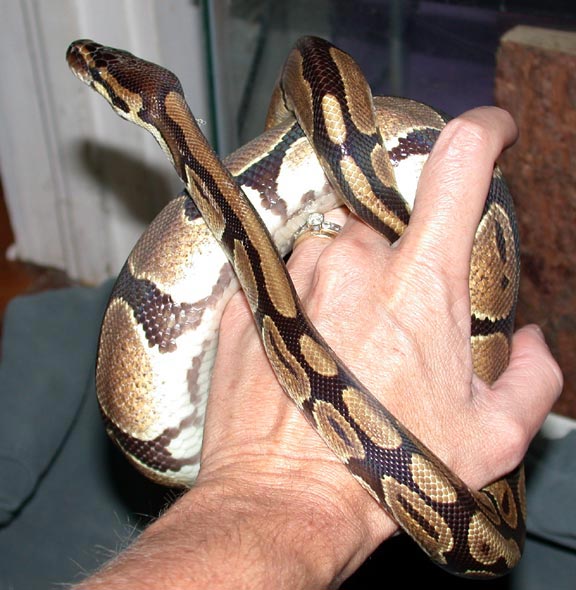Ball Pythons
I received my
first Ball Python in June of 2002. His name is Rufus  and he was a rescue. He was supposedly about 4 years old yet only weighed
in at 15 ounces. He was quite thin and had mites.
and he was a rescue. He was supposedly about 4 years old yet only weighed
in at 15 ounces. He was quite thin and had mites.
Oddly enough he was/is a very good eater and put on weight very quickly. I fed him once every 5 days to get him started. He started with mice and has moved up to frozen/thawed small rats. Soon I plan to move him to medium sized rats.
Why no Ball
Pythons until now?
I had avoided Ball Pythons like the plague for years and years even though it was a Ball Python that lured me into the reptile hobby in 1992. I avoided them because of the problems associated with them. The biggest problem I had read about was their eagerness to cease eating for no apparent reason. They were also rumored (in general) to take live food.
In recent years it has come to my attention that the aforementioned problems are mainly due to their wild caught status. It seems that truly captive bred Ball Pythons don't have these feeding issues. More and more captive breds are available all the time.
Back to the
Ball Pythons we have here...
As of October, 2002 Rufus continues to fatten up and grow. He now weighs in at about 3 lbs. I use him at educational shows as he has a very nice disposition.
In September, 2002 we received two more "rescues" from a nice home here in CT. This pair was taken care of very well. The people that gave them up simply didn't have time for them anymore. The female came to us quite fat but the male hadn't eaten in 10 months, since November of 2001! This is what I was talking about when I said that wild caught Ball Pythons sometimes go off their feed. Well, after they were here for about 3 days I attempted to feed them. The male fed instantly on a small frozen/thawed rat!!! This was very exciting as I was sure we were in for a long haul that could end up with us force-feeding.
General Information
As of late fall 2003 we are keeping all of the Ball Pythons seperately. Rufus is in a 20 gallon long tank that he is rapidly outgrowing. The new female is in a lovely Neodesha cage that is 36"x18" and the new male, Buddy, is in a 40 gallon breeder tank that is also 36"x18". Rufus is in a warm room and only has an undertank heater as supplemental heat. The other two are in a slightly cooler room and have overhead red lights on 24 hours a day. They are all on aspen bedding with large water "pools". They are fed weekly for now. We may go to an every other week schedule at some point when everyone is fattened up properly.
Breeding
Well, we did breed Rufus to the adopted female during the Winter/Spring of 2003. She was really really heavy bodied going into the breeding season. I "cooled" them down to the low to mid 80s for several months over the winter. I observed breeding activity several times. In March I brought the temps back up and started offering food again. The male started to eat right away while the female did not. She laid 7 eggs that Spring. All of the eggs hatched. Unfortunately one of the babies somehow wedged his head between the edges of the cover of the container in the incubabor and perished before we got to him. The other 6 all made it just fine except for one that refused all offers of food and eventually starved to death in October of 2003. I placed/sold most of them. I still have one left that I think I shall keep. She (he?) is huge and a great eater!
Click here for a printable Ball Python Care Sheet
Good
Ball Python Books
Click to buy them at Amazon.com
© 2005, www.reptilecare.com. All rights reserved.


